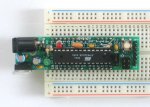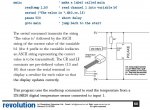This RedHerringisation or tangentification happens quite often Crafty - quite funny isn't it. I'm surprised we haven't got onto politics and feeding the World.
Yeah, I think we get the idea of your proposal.
I think a lot of people
agree, generally, that a PICAXE+basics on a single small board would be quite attractive.
Trouble is the balance between what-to-stick-on and cost is tricky, hence the suggestion for a Stampified unit + EEPROM which would be fairly cheap.
If you start adding RTCs the price goes up. All said before.
If you start adding lots of things then you're moving from a Stampified PICAXE (cheapish) to a Single Board Computer (not so cheap).
And then there's the cost... do a basic design and get a estimate for, say, 200 off.
My feelings so far: It's a good idea. Its an appealing idea. It would make life easier for the Newbie. But many people here are so tight it beggars belief. Some will spend pounds to save pennies. If its altruism that drives this idea then you're very kind. If its a commercial idea then leave it to someone who can get the bits cheaper AND can market it. Maybe Rev-Ed have done some M.R. and costings and considered it as a no-goer?
"I personally can see one or two of my future projects that definitely would make good candidates for using such "small" format PCB's - surely there must be other PICAXE users out there in the same category..?"
- I'm sure you're prefectly correct.
I'm sure there are. But how are you going to find out?
Taking a general view of the responses on this thread, you will see that there are a lot of responses... but from the 'same old faces' including me.
If you'd had 30 keen replies from 30 different Forumites then I'd have said there was some mileage.
If people were really keen then even casual Forum 'Guests' would have registered to express their enthusiasm, so I wouldn't use this as Market Research

Remember, people could Google until they were blue in the face without finding this thread, so they'll never be able to say 'Yes Please. How much?'.
A lot more is required, sadly, than an interesting question on the Forum.
Would I buy one? If I was starting out
and it was significantly cheaper than the BS equiv
and had a Reset pin then I would. An 18X based baby and a 28X1 based big boy would be my initial thoughts. I find the BS so prohibitively expensive that I wouldn't consider it for a second but it has a market and, IMHO, superior documentation.
Anyway 'nuff said. Good luck.






